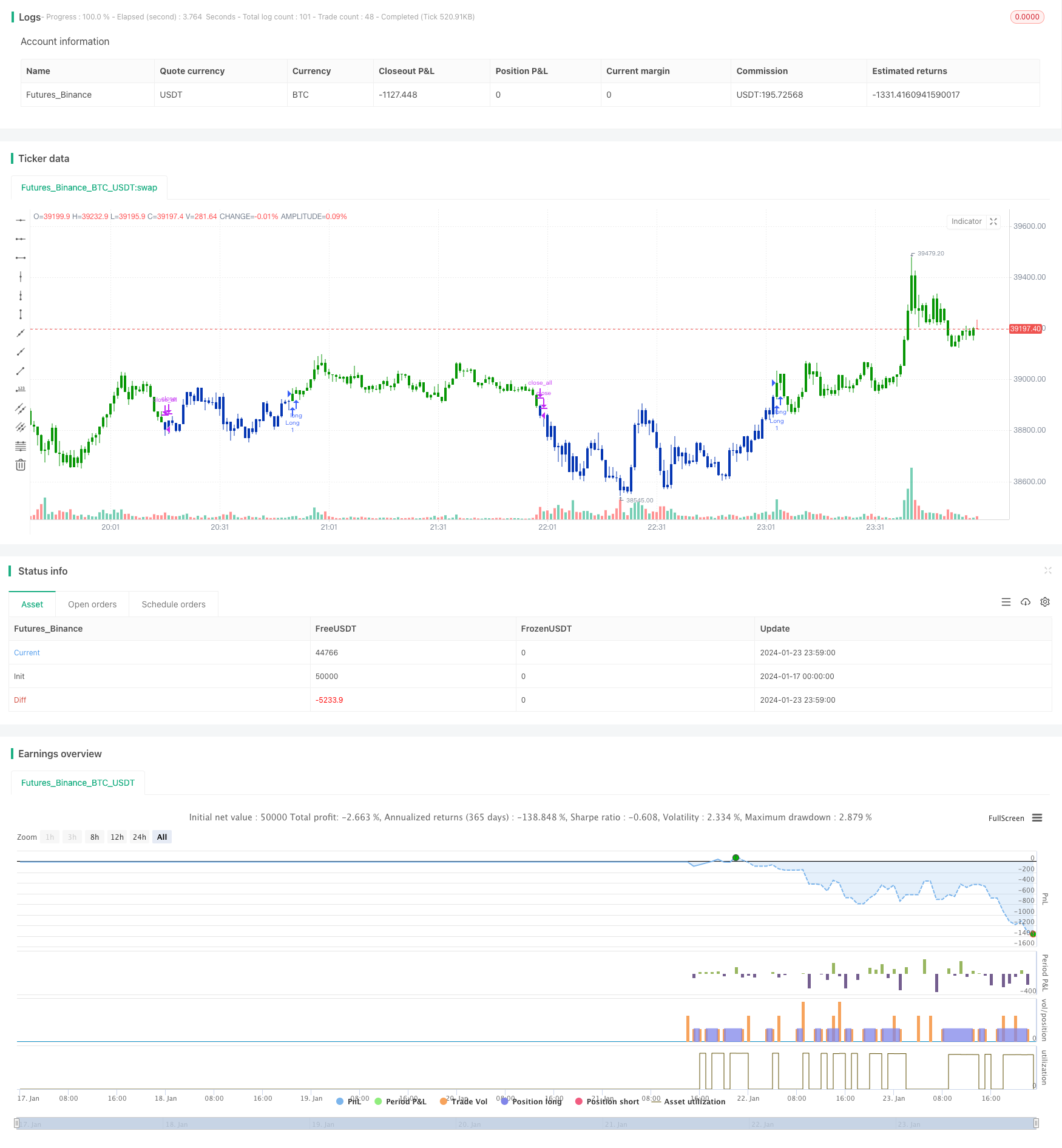
概述
本策略通过结合动量张弛指标和123形态两个策略,形成一个综合交易信号,以提高盈利概率。其中,动量张弛指标追踪市场波动性,调整RSI参数以捕捉短期趋势;123形态则利用股票短期内的高点、低点形成交易信号。两种策略的结合可以使策略在不同市场环境下保持交易效果。
策略原理
123形态
123形态分为三个阶段,第一个阶段股价连续两天下跌,然后第二阶段股价连续两天上涨,最后第三阶段股价再次下跌。根据该形态我们可以判断,在第二阶段股价上涨时可以建立多头仓位,而在第三阶段股价下跌时可以建立空头仓位。
具体来说,当收盘价连续两日下跌后,如果第三日收盘价高于前一日收盘价,同时9日Stochastic Slow低于50,则为买入信号;当收盘价连续两日上涨后,如果第三日收盘价低于前一日收盘价,同时9日Stochastic Fast高于50,则为卖出信号。
动量张弛指标
动量张弛指标的构建过程与RSI大体相同,主要区别在于动量张弛指数的周期长度是可变的。具体来说,该指标的周期长度受到最近期价格波动率的影响。价格波动越大,周期越短,从而使得指标更加敏感;价格稳定时,周期越长,以减少误报率。
动量张弛指数的计算公式为:
DMI = RSI(DTime)
其中:
DTime = 14 / X日收盘价标准差的10日均值
该指标与RSI的界定范围相同,多空区域如下:
多头区域:DMI > 30 空头区域:DMI < 70
当指标由空头区域进入多头区域时产生买入信号,由多头区域进入空头区域时产生卖出信号。
优势分析
123形态简单有效。该形态利用股价短期反转特征,在次级底部买入,次级顶部卖出,避免在趋势中期交易。
动量张弛指数更敏感。指标的变速特性使其能够自适应市场,在剧烈波动中及时捕捉转折点。
两种策略可以有效过滤误报。123形态产生信号时再参考DMI判断市场背景,可以减少在趋势中交易带来的亏损。
结合利用两种策略优点。DMI适合作为过滤器使用,结合123形态可以大幅提高系统稳定性。
风险分析
容易产生信号误报。DMI和123形态都可能在价格只是短期波动而未转向时产生错误信号。
交易频率可能过高。DMI变周期特性使其对市场噪音极为敏感,需要适当调整参数以控制交易频率。
123形态可能错过趋势中期机会。该形态主要捕捉短期反转,无法持续获利于中长线走势中。
需要适当限制交易次数。交易次数过多会带来高额的手续费和滑点成本。
优化方向
优化动量张弛指数参数。可以测试不同DMI的RSI参数、交易区间参数,找到最佳参数组合。
优化123形态过滤条件。可以测试Stoch指标不同参数或其他过滤指标如MACD。
增加止损机制。适当缩止损幅度可以减少单笔损失。
增加位置管理模块。例如固定数量交易、固定资金利用率交易等可以完善策略风险控制。
总结
本策略通过结合动量张弛指数和123形态两个角度判断市场,旨在提高交易信号的效果。但任何单一策略都无法完美适应市场的变化,投资者在使用时需要注意控制风险,并根据回测和实盘结果不断调整优化参数,使策略能够持续盈利。
/*backtest
start: 2024-01-17 00:00:00
end: 2024-01-24 00:00:00
period: 1m
basePeriod: 1m
exchanges: [{"eid":"Futures_Binance","currency":"BTC_USDT"}]
*/
//@version=4
////////////////////////////////////////////////////////////
// Copyright by HPotter v1.0 18/03/2020
// This is combo strategies for get a cumulative signal.
//
// First strategy
// This System was created from the Book "How I Tripled My Money In The
// Futures Market" by Ulf Jensen, Page 183. This is reverse type of strategies.
// The strategy buys at market, if close price is higher than the previous close
// during 2 days and the meaning of 9-days Stochastic Slow Oscillator is lower than 50.
// The strategy sells at market, if close price is lower than the previous close price
// during 2 days and the meaning of 9-days Stochastic Fast Oscillator is higher than 50.
//
// Second strategy
// This indicator plots Dynamic Momentum Index indicator. The Dynamic Momentum
// Index (DMI) was developed by Tushar Chande and Stanley Kroll. The indicator
// is covered in detail in their book The New Technical Trader.
// The DMI is identical to Welles Wilder`s Relative Strength Index except the
// number of periods is variable rather than fixed. The variability of the time
// periods used in the DMI is controlled by the recent volatility of prices.
// The more volatile the prices, the more sensitive the DMI is to price changes.
// In other words, the DMI will use more time periods during quiet markets, and
// less during active markets. The maximum time periods the DMI can reach is 30
// and the minimum is 3. This calculation method is similar to the Variable
// Moving Average, also developed by Tushar Chande.
// The advantage of using a variable length time period when calculating the RSI
// is that it overcomes the negative effects of smoothing, which often obscure short-term moves.
// The volatility index used in controlling the time periods in the DMI is based
// on a calculation using a five period standard deviation and a ten period average
// of the standard deviation.
//
// WARNING:
// - For purpose educate only
// - This script to change bars colors.
////////////////////////////////////////////////////////////
Reversal123(Length, KSmoothing, DLength, Level) =>
vFast = sma(stoch(close, high, low, Length), KSmoothing)
vSlow = sma(vFast, DLength)
pos = 0.0
pos := iff(close[2] < close[1] and close > close[1] and vFast < vSlow and vFast > Level, 1,
iff(close[2] > close[1] and close < close[1] and vFast > vSlow and vFast < Level, -1, nz(pos[1], 0)))
pos
DMI(RSILen, BuyZone,SellZone,UpLimit,LoLimit) =>
pos = 0
xStdDev = stdev(close, 5)
xSMAStdDev = sma(xStdDev, 10)
DTime = round(14 / xSMAStdDev - 0.5)
xDMI = iff(DTime > UpLimit, UpLimit,
iff(DTime < LoLimit, LoLimit, DTime))
xRSI = rsi(xDMI, RSILen)
pos := iff(xRSI > BuyZone, 1,
iff(xRSI < SellZone, -1, nz(pos[1], 0)))
pos
strategy(title="Combo Backtest 123 Reversal & Dynamic Momentum Index", shorttitle="Combo", overlay = true)
Length = input(14, minval=1)
KSmoothing = input(1, minval=1)
DLength = input(3, minval=1)
Level = input(50, minval=1)
//-------------------------
RSILen = input(14, minval=1)
BuyZone = input(30, minval=1)
SellZone = input(70, minval=1)
UpLimit = input(30, minval=1)
LoLimit = input(5, minval=1)
reverse = input(false, title="Trade reverse")
posReversal123 = Reversal123(Length, KSmoothing, DLength, Level)
posDMI = DMI(RSILen, BuyZone,SellZone,UpLimit,LoLimit)
pos = iff(posReversal123 == 1 and posDMI == 1 , 1,
iff(posReversal123 == -1 and posDMI == -1, -1, 0))
possig = iff(reverse and pos == 1, -1,
iff(reverse and pos == -1 , 1, pos))
if (possig == 1)
strategy.entry("Long", strategy.long)
if (possig == -1)
strategy.entry("Short", strategy.short)
if (possig == 0)
strategy.close_all()
barcolor(possig == -1 ? #b50404: possig == 1 ? #079605 : #0536b3 )